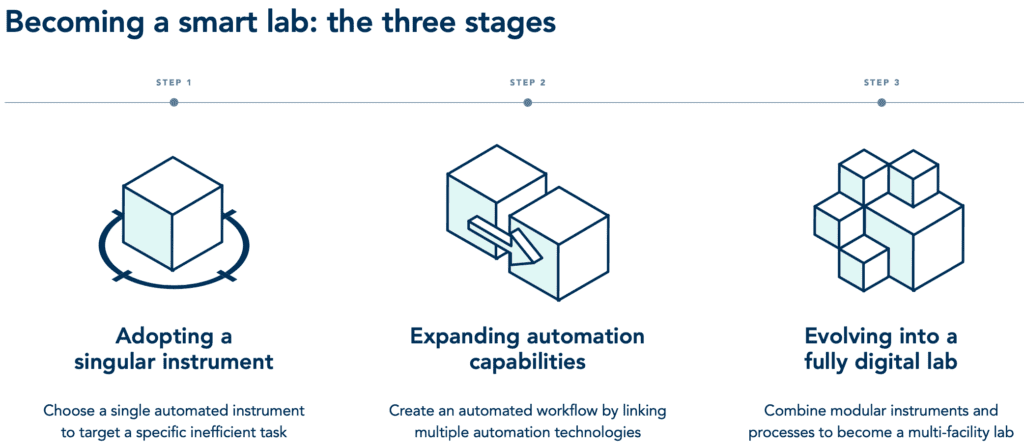

Becoming a smart laboratory: The three stages
The steps for finding the lab automation solution that’s the right fit for where you are now
Open, integrated automation is needed today for laboratories to remain competitive and meet demand. It is a fact that we will see more and more labs where humans and robots are working side-by-side imminently.
We may even start to see “lights out labs” – operating 24 hours a day, maximising their efficiency and shortening schedules for faster delivery of results – or lab technicians embracing hybrid working, making use of new technology such as humidity and temperature sensors to monitor assays remotely.
If you’re considering taking the next step in your lab automation journey today, or just getting started, we are here to help. Our advice is to start small and expand later. With that in mind, here’s what your next step could look like.

1. Target a specific inefficient task
The best place to start is by automating the dull, strenuous, and repetitive jobs. You’ll take the pressure off staff who’d otherwise be expected to stand over their experiments for hours and hours every day and give them more walkaway time to focus on the work that uses their expertise and skill set. Some lab processes that are ripe for automation include sample logistics; cell line maintenance; QA testing; repetitive assays.
2. Link multiple automation technologies to create an entirely automated workflow
Take the automated liquid handler, for example. Liquid handling is just one step towards eliminating repetitive, mundane and manual processes in the lab. Many labs are still unable to meaningfully increase walkaway time, activity levels and results, and improve accuracy. This is because the rest of the sample preparation stages – such as loading, capping and uncapping, bar code scanning, weighing, and transferring – are still performed manually. Automating every single task in a workflow would make the process faster, more precise and less prone to human error.
3. Combine a collection of modular instruments and processes to become a multi-facility lab
With start-ups and scale-ups innovating at an ever-increasing rate, automation will have to adapt to high-growth situations where scientists are moving away from traditional, fixed systems. Traditionally, integrators and partners will combine multiple modular instruments, which in the past has been a costly and inflexible process. However, as automation in labs becomes more democratised by partners like Automata, we can increase the flexibility of bringing these solutions to life with robotic and digital connections. Thinking modular enables lab design to be adaptable and scalable so they can re-configure their workflow and scale to meet changing requirements. A host of features, a dynamic scheduler, and our unique transport layer, gives any sample access to any machine in a contiguous set of benches. That means labs are working with a hyper adaptable system that can dynamically manage changes in workflows and throughput demands.
Learn more about how to use open, integrated automation to become a smart lab. Download our whitepaper ‘The journey to the fully automated labs of the future‘.

